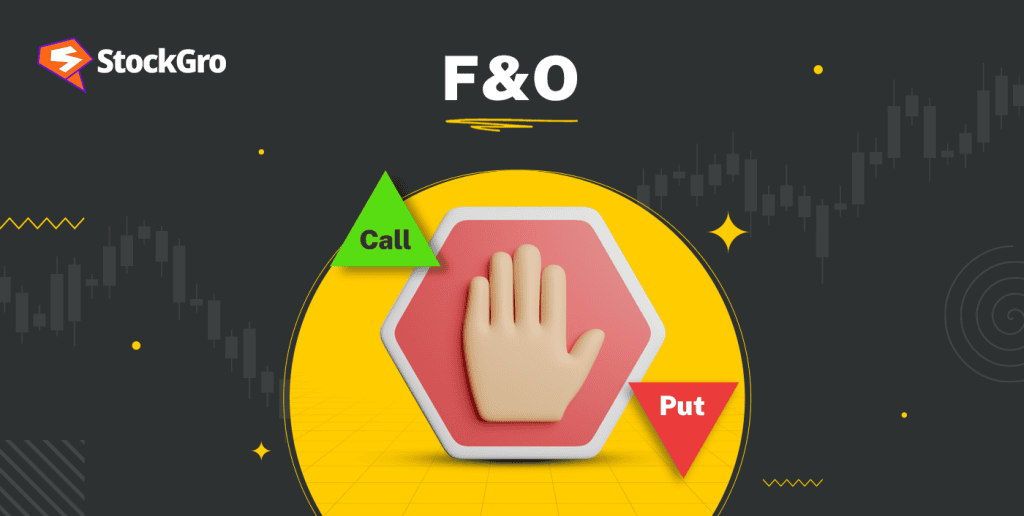
Derivatives trading can look like a gold mine to a beginner trader. High returns of futures and options attract a large number of traders and sooner or later most traders realise it was a mistake. According to a SEBI study, from FY22 to FY24, 93% of traders involved in futures and options lost money.
In this article, we will look at some of the common mistakes that derivatives traders make that make them lose money and how these mistakes can be avoided.
Some common mistakes made by F&O traders
Derivative contracts like futures and options have the potential to double in value in a single day, but they can also lose almost all their value in a few hours. Traders enter this market thinking that they will walk out rich, but almost always, the opposite happens. So, what have they been doing wrong that 93% of them are losing money? Let us look at some common mistakes.
- Lack of knowledge: Futures and options traders usually underestimate the complexity of this segment. Futures and Options take years to learn and master. Beginners often enter this market without complete knowledge and face difficulty in navigating through various market phases. Understanding each and every aspect of this market is of utmost importance before risking money.
For example, sometimes Nifty 50 option contracts double in value in a single day, but they can also lose all their value in a few hours. There are more factors at play than a beginner’s mind can comprehend.
- Overleveraging: F&O contracts are designed to provide leverage. Meaning that a trader can take a much bigger position than their actual capital. Although this magnifies returns, it also magnifies the risks. Traders often take excess leverage, thinking that they can make maximum gains with minimum capital, and they ignore or underestimate the risks.
- Ignoring risk management: Many beginners underestimate the risks involved in futures and options trading. Futures and options are highly leveraged. For example, Nifty 50 options have a lot size of 25, meaning these are leveraged 25 times. A 10-point move in Nifty 50 can lead to a ₹250 move in a Nifty 50 options contract. During periods of high volatility, traders can lose a significant portion of their capital if the market moves in an unfavorable direction.
- Chasing loses: Sometimes beginners have a good risk management plan ready with their stop losses and profit trading targets set. But after a losing trade, their emotions take the better part of them, and all the risk management theory and trading plan goes down the drain. They start taking low-probability, very poor trades, thinking that they might hit the jackpot. This leads to a cycle of poor decision-making.
- Neglecting market conditions: It is often the case that after a profitable trade, traders get greedy. They start making more trades to earn a little more money. This is called overtrading, and while doing so, they often ignore market signals.
Greed also leads traders to take trading positions based on tips, rumors, or speculation. This leads to poor trades that do not align with underlying market conditions.
- Poor exit strategies: Traders often fail to make a clear exit plan. An exit plan tells you how much profit or loss per trade you are willing to make and when to stop. Traders keep their winning positions open to make even more money, and they keep their losing positions open, hoping they might recover.
- Neglecting diversification: Some derivative contracts are very expensive to buy, and a trader might deploy all their capital to buy a single contract. This increases their risk exposure significantly. Their portfolio gets concentrated in one or two contracts.
Even if a trader has ample capital, they have a tendency to ignore diversification and buy highly correlated contracts, which leads to heavy losses in adverse market conditions.
Also read: Unlocking the power of index futures: A beginner’s guide
How to avoid F&O trading mistakes
Here are some techniques you can use to avoid these mistakes.
- Educate yourself well. Learn about derivatives not just from a course or a book. Try to have hands-on experience. Start from a small portion of your capital and slowly increase it if you feel you are heading in the right direction. Remember that in this market, learning is a continuous process.
- Have a proper trading plan with pre-defined rules for entry, exit, profit targets, and stop losses, and a proper position sizing plan. Try to find and learn from a good mentor.
- Learn more about emotional biases and try to control your emotions. Controlling your emotions in trading comes from experience. It takes time to learn this craft, but it is an important one.
- Keep a journal where you write down about your mistakes and emotions. To avoid repeating them in the future.
- Back-test your trading strategy properly and keep updating it according to changing market conditions.
- Understand the product you are trading well. You must know the brokerage charges, leverage, risk exposure, etc, in advance about the contract you are trading.
Also read: Stock options – The beginner’s guide to the options market
Conclusion
Trading in futures and options can feel exciting and thrilling in the beginning as traders only focus on the returns and completely ignore the risk element. But remember that derivatives can be very risky. A trader must understand derivatives trading in detail before getting into these markets. Along with that, a proper understanding of risk management and position sizing is also necessary. Always have a back-tested trading plan.
Also read: Using options and derivatives in investment
FAQs
1. What is the most common mistake a trader makes in the F&O market?
Traders make the mistake of thinking they have the appropriate knowledge to become a successful futures and options trader. They think they have the ability to predict market movements. Also, beginners give more weightage to unsolicited tips and rumors, which in turn magnify their losses. Educating oneself properly before entering the derivatives market is of utmost importance.
2. How can a trader avoid common mistakes while trading futures and options?
A trader can limit their losses by avoiding common mistakes. Firstly, a trader must learn properly. Secondly, the risk management, position sizing rules, and entry and exit strategy must be properly defined and back-tested. Traders must also learn how to control their emotions. Maintaining a daily trading journal can be very helpful.
3. Why is emotional control important in trading?
Emotions like greed, fear, and overconfidence can be really dangerous for a trader. Under the influence of these emotions, a trader makes trading decisions that they might have avoided otherwise. Successful traders have regularly re-emphasized the importance of controlling their emotions in their trading success. An understanding of emotional biases is really important.
4. How can overleveraging become a problem?
Derivative contracts are leveraged contracts, and traders can have very high returns, but the risk also becomes irrationally high. A slight increase in volatility and a move in the unfavorable direction can lead to huge losses. So, a trader must understand the amount of leverage they are taking per contract and the associated risks.
5. What is revenge trading and how can it be stopped?
Revenge trading refers to trading that is done with the hope that a trader might recover their losses. After making a few losses, traders start taking trading positions thinking that they might finally hit the jackpot and recoup their losses. But it leads to further losses. It becomes a cycle and losses keep getting amplified. Revenge trading can be stopped by controlling emotions and having a proper trading plan.

